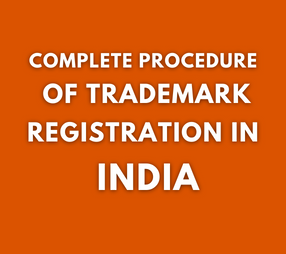INTRODUCTION:
Trademark registration refers to the filing of an application for the registration of a design, symbol or logo created by a particular company for their use only. It is an extremely important process to prevent infringement of the trademark rights of a company by any misuse whatsoever. Investing time, money and ideas for creating a trademark that results in being used by a third party for their convenience without any authorization is disheartening and not agreeable. Therefore, trademark owners should be protected from such frivolous activities and from facing unnecessary litigation charges by registering their trademarks with the government and getting the required legal protection.
The process of trademark registration is quite easy yet a lengthy one. It can take up to months or years to complete the entire process of registration. However, an application number is provided within a short span of time after filing. The basic steps of trademark registration in India are as follows:
TRADEMARK SEARCH:
The first step in the process of trademark registration is the search for a trademark that is to be registered. This step involves scrutinizing the existing trademark logos to ensure that the one created by the company is new and no existing trademark looks similar to it. It is the best way to avoid litigation charges as it gives a fair picture regarding the uniqueness of the logo or design. Usually, this process is undertaken by the trademark attorney whether offline or online. After the search is complete in every way possible, the next step in the procedure for registration of the trademark must begin.
FILING A TRADEMARK APPLICATION:
After the uniqueness of the trademark has been established by the trademark attorney of the company, the application for the registration has to be filed before the Trademark Registry of India. However, if the trademark is taken or is similar to another logo, the design has to be modified and altered accordingly. Once it is ensured that the logo is not listed with the Trademark Registry of India, the application is filed online and the company is permitted to use the ™ symbol thereafter.
EXAMINATION:
Once the application has been filed with the Trademark Registry India, it is sent for examination. In case of any discrepancy or disparity, the examiner can object the application and send it back to the owner for rectifications. However, the examiner can also send it back in case there is any minor objection in the application. It is the duty of the trademark owner to make the changes be it minor or major and re-send the application to the Trademark Registry within a tenure of one month. Subsequently, the trademark is sent for publication after it meets the requirements of the examiner.
PUBLICATION:
The process of publication involves inviting any sort of objection from the general public. Once the trademark has been published, and no objection is received within 3 to 4 months, then it proceeds for registration. However, in case of any objection or opposition, the case is heard by the Registrar and a fair decision is taken by him. The entire process of the trademark application, examination and publication is known as trademark registration.
TRADEMARK REGISTRATION CERTIFICATE:
Once the trademark has been approved by the examiner and is sent for publication, it becomes eligible for being registered. But once it crosses the step of publication without any objection, it becomes clear that a trademark registration certificate can be issued for the same. A Trademark Registration Certificate is issued under the deal of the Trademark Office to the company thereby declaring that a particular logo or design has been registered under the name of that company.
RENEWAL OF THE TRADEMARK:
The validity of a trademark registration lasts for 10 years only. Therefore, to protect the logo and prevent any infringement of trademark rights, the trademark needs to be renewed every 10 years. If the mark is not renewed once it has expired, and another company files for an application with the same logo and gets registered with it, the right over the logo shifts from the older company to the new one. Thus renewal is a very crucial step in the procedure of trademark registration.
Even the large and enormous industries have to get their trademarks registered in order to protect them from being infringed or misused without their permission. The goodwill and loyalty earned by a company stimulate a lot because of its trademark. It serves as an asset for the company and thus contributes to building its identity.


No comment